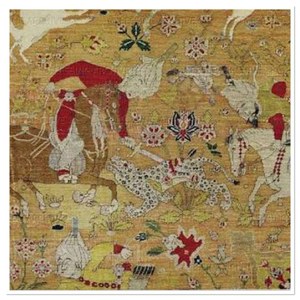Another fine example from the same era is the hunting carpet in the Poldi Pezzoli Museum in Milan. It is one of the rare carpets that is dated in an inscription that says: “It is by the efforts of Giyath-ud-Din ʿJami that this renowned carpet was brought to such perfection in the year (1542 AD)"; and is thus historically significant.
Archeaological finds date the domestication of horses to around 3,500BCE in the Eurasian Steppes and Kazakhstan, but a beautiful cave painting of horses found in Lascaux, France, dating to 17,000 BPE, might suggest a much earlier time that humans and horses lived closely together. Another great depiction of a horse dating from the late Bronze Age is the Uffington White Horse situated on the upper slopes of the White Horse Hill in the English civil parish of Uffington and is about 110 m long formed from deep trenches filled with crushed white chalk.
Throughout our history horses have played a pivotal role in our societies from being the main form of transportation to being an animal that we can play with. It is no wonder that we immortalized them in our arts and crafts. The dressing of horses were as important as the dressing of their owners and great craftsmanship were employed to make/weave unbelievable horse blankets and saddlebags for the horses. No expense was spared to ensure that the horses were dressed up from head to tail in the most elaborate of ways.
Horses were often featured in the Persian carpets as is evident in the Pazyryk carpet (oldest remaining piled carpet), but during the Islamic invasion of Persia the portrayal of humans and animals in art was forbidden. It would only again be revived by the Safavid rulers who were keen patrons of the arts and requested the great master weavers to create carpets that depicted the royal horses, hunters and sportsmen on horseback. Polo was a game used to prepare soldiers for combat and was a great source of entertainment together with hunting. It is often depicted in carpets and miniature paintings of the time.
Today hunting carpets are still produced mainly in Isfahan, Iran, and because of the fine detail required they are mostly woven with silk. Horse blankets and saddlebags are also still produced albeit mostly for the owner’s own use. Pictured here is an antique Kurd Khorasan saddlebag in the Ghorbany Private Collection.
Written by Vanessa Ghorbany
References:



